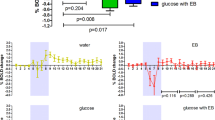Abstract
IN the electrical self-stimulation procedure, food deprivation will increase the rate of lever pressing if the stimulating electrodes are located in or near the “feeding area” of the lateral hypothalamus1. The known functions of this region suggest at least two ways in which this effect might be brought about.
Similar content being viewed by others
References
Margules, D. L., and Olds, J., J. Comp. Physiol. Psychol., 51, 320 (1958).
Mayer, J., and Sudsaneh, S., Amer. J. Physiol., 197, 274 (1959).
Herberg, L. J., and Blundell, J. E., Science, 155, 349 (1967).
Deutsch, J. A., and Di Cara, L., J. Comp. Physiol. Psychol., 63, 344 (1967).
Duda, J. J., and Bolles, R. C., J. Comp. Physiol. Psychol., 56, 569 (1963).
Reed, J. D., Psychol. Bull., 44, 393 (1947).
Berlyne, D. E., Conflict, Arousal and Curiosity (McGraw-Hill, 1960).
Author information
Authors and Affiliations
Rights and permissions
About this article
Cite this article
BLUNDELL, J., HERBERG, L. Relative Effects of Nutritional Deficit and Deprivation Period on Rate of Electrical Self-stimulation of Lateral Hypothalamus. Nature 219, 627–628 (1968). https://doi.org/10.1038/219627a0
Received:
Revised:
Issue Date:
DOI: https://doi.org/10.1038/219627a0
- Springer Nature Limited
This article is cited by
-
Lateral hypothalamic GLP-1 receptors are critical for the control of food reinforcement, ingestive behavior and body weight
Molecular Psychiatry (2018)
-
Dopamine D2 receptors in addiction-like reward dysfunction and compulsive eating in obese rats
Nature Neuroscience (2010)
-
Nicotine Self-Administration Acutely Activates Brain Reward Systems and Induces a Long-Lasting Increase in Reward Sensitivity
Neuropsychopharmacology (2006)
-
Feeding, drug abuse, and the sensitization of reward by metabolic need
Neurochemical Research (1996)
-
Possible mechanism for the effect of anorexic agents on feeding and hoarding behaviour in rats
Psychopharmacologia (1971)




